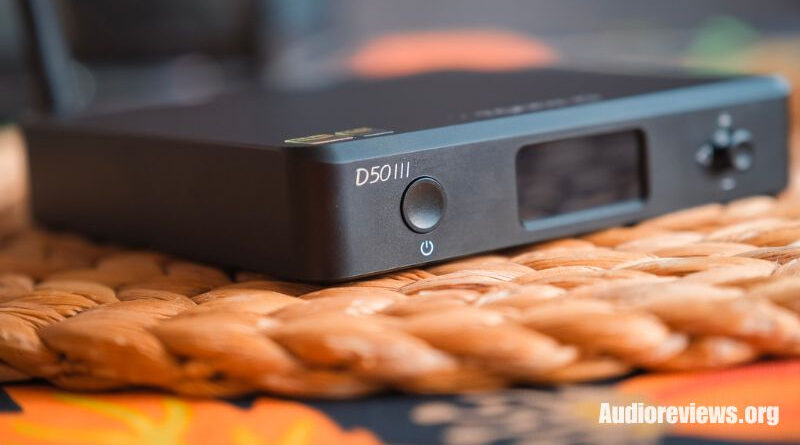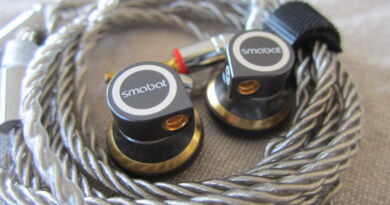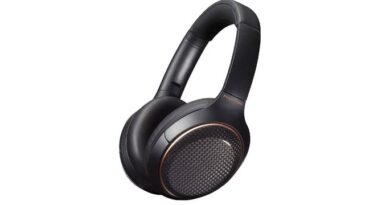Topping D50 III DAC Review – Balanced To A Fault
The Topping D50 III nails the sonic fundamentals and sprinkles 10 PEQ bands on top but it faces tough competition.
PROS
- Great technical performance for the price
- Desktop-friendly form factor
- PEQ has great potential
CONS
- Short TRS cables can be hard to find
- Some might prefer more color to the sound
- Strong competition at the price point
In this Article
Introduction
If something measures perfectly, is this review anything more than a report on my hallucinations? Topping and SMSL have long been the go-to brands for people who value measured electronic performance above everything else but does it mean that brands like these have nothing to offer for the discerning listener with a heart?
Read on to find out as I take Topping’s newest midrange desktop DAC through its paces and see if my ears agree with those graph-peeping eyes of mine!
Specifications
DAC chipset: 2x ESS ES9039Q2M Analog stage: proprietary opamp-based USB receiver: XMOS XU316 Bluetooth receiver: QCC5125 Data input rates: PCM – up to 32bit 768kHz, DSD – up to DSD512 native, DOP256 Output voltage: 2.5Vrms SE, 5Vrms BAL (can be switched to standard 2Vrms and 4Vrms mode) Frequency range: 20-40,000Hz@-0.3dB Output impedance: SE – 50ohm, BAL – 100Ohm SNR: 127dBA SE, 132dBA BAL THD+N: <0.00008%@1kHz SE, <0.00006%@1kHz BAL Inputs: USB type-c for data and power, separate type-c port for power only, RCA SPDIF, Toslink, Bluetooth (LDAC, aptx-Adaptive, aptx-HD, AAC, SBC) Outputs: RCA, TRS (BAL) EQ: 10 parametric EQ bands with peak, low-pass, and high-pass functions; amplitude adjustment -12dB to +12dB, Q-factor adjustment 0.1 to 15. Size: 125x131x45mm Tested at: $229 Purchase Link: Shenzhen Audio |
Physical Things and Usability
| In The Box: D50 III DAC, Bluetooth remote, Bluetooth antenna, USB-A to C cable, USB-C to C cable, paperwork |
| Appearance, Haptic, Build Quality: the milled aluminum unibody feels hefty, design choices like fonts limit premium feel, the joystick and remote feel less premium than the unit itself |
| Ergonomics: the size is perfect for desktop use however, the tiny screen will be hard to read from usual living room distances |
Build quality
When was the last time you had a CNC-milled chassis in a product under 1000$? Even before switching the Topping D50 III on I was wowed by how solid the physical feel of the unit is. Only the choice of labeling font betrays the pricepoint of the D50III and maybe the little dinky joystick that’s used for controlling it.
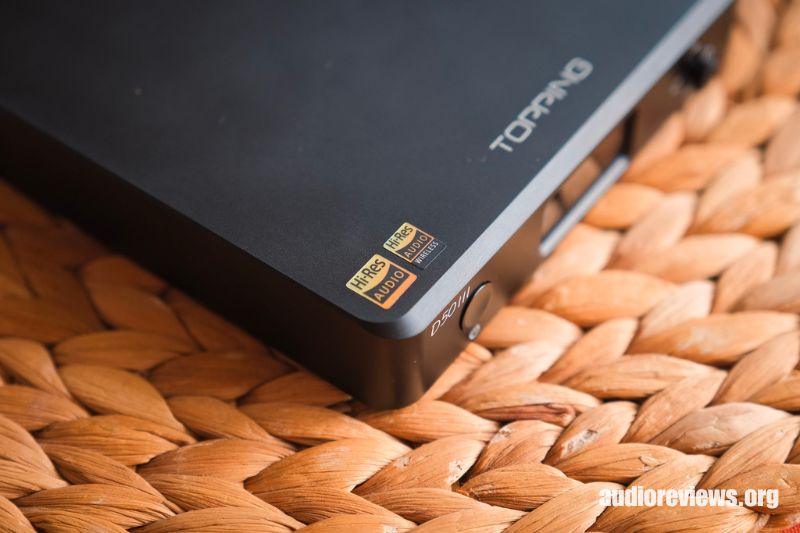
The front of the Topping D50 III houses the ON/OFF button, screen, and 4-direction joystick. On the back, we get the I/O which has at least one point of interest this time. Powering the DAC can be done via the same port the USB data comes from or through a separate power-only USB-C port. The latter scenario will be used if only inputs other than USB are used as neither Bluetooth, SPDIF nor Toslink can deliver power.
Controls
The basic controls of the Topping D50 III are accessed by using the directional joystick – up and down for volume and sideways for flicking through the inputs. There is a pretty extensive menu system one can access by short-pushing the power button and it allows one to change the regular ESS DAC options like low-pass filters and others like output levels, preamp vs fixed mode, and EQ. I found it to be reasonably easy to use for occasional adjustments. The Bluetooth remote allows for more direct option changes.
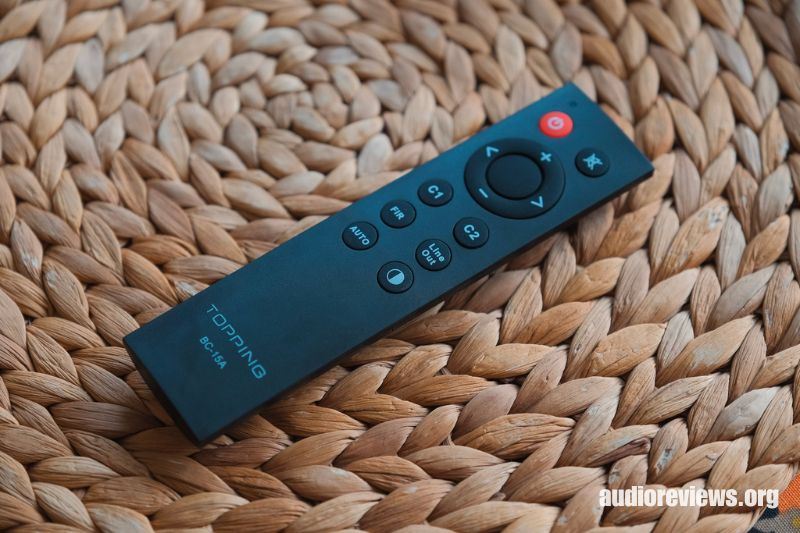
As with some other DACs that use the XMOS XU316 chip, the Topping D50 III can utilize its DSP capabilities and do parametric equalization. The configuration is done through a Windows app (no MacOS for now) that allows for setting up to 10 PEQ bands and storing them in D50 III onboard memory. Then you use the on-device menu to enable or disable the EQ and select the profiles you want. A properly configured EQ can be invaluable for headphone tuning or speaker and room correction.
Under the hood
I’m happy to report that getting under the hood of the Topping D50 III was a breeze. Realizing that all of the bolts could be undone by the same size hex key was a nice cherry on top. The overall quality of construction is pretty neat with good SMT soldering quality and only the through-hole parts could’ve used some resin residue cleaning. My only reservation is that many IC’s have their lettering etched off which reduces repairability.
The PCB layout of the Topping D50 III tells the story of a unit built to a budget. USB power means that all digital and analog power rails are derived from the 5VDC input by using buck converters. A more purist approach would be to use an AC voltage supply and then regulate down the needed voltages but Topping is using the space and budget constraints rather smartly. After all, the DAC can be used on any device with a USB port. And let’s be honest, some more high-end DACs also use this approach.
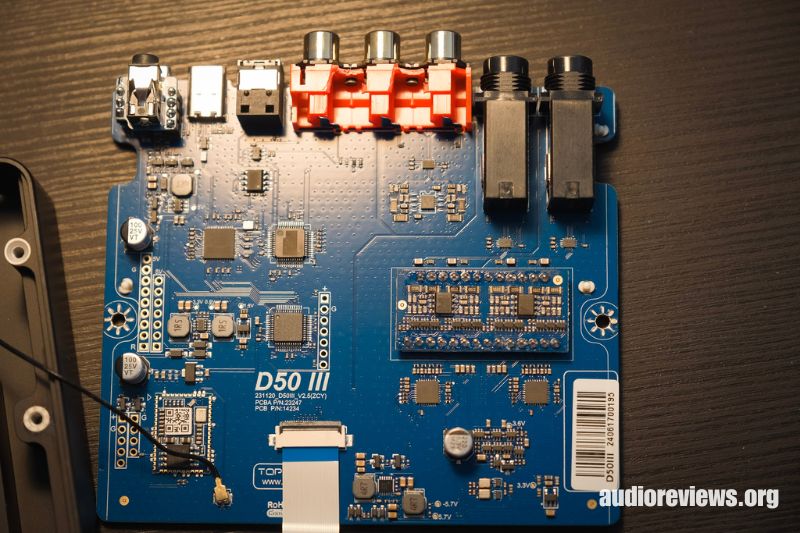
By looking at the chip layout we can gauge the working principles of the D50 III. The USB input branches out the power and the data side which then goes into the XMOS XU316 receiver. It takes incoming audio and applies DSP processing to it if the EQ is used. Then it outputs the I2S signal to the jitter-cleaning circuit which is then routed to the double ESS ES9039Q2M DAC chips. Both SPDIF and Toslink use their own receiver which means that DSP can only be done for USB audio. Bluetooth is processed by a QCC5125 daughter board. In theory, this Bluetooth receiver can also do DSP, if programmed as such.
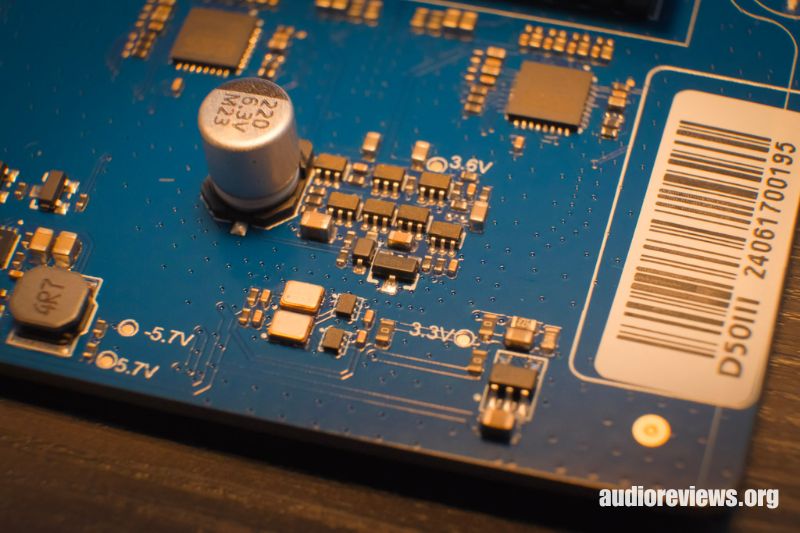
After the DAC section, we see two double-sided PCB daughter boards that house the “new” IV stage. It prepares the audio signal that comes from the DAC and essentially isolates the sensitive DAC circuitry from the harsh outside world. I’m not too happy that the opamps have their labeling also erased which likely means that Topping isn’t using crowd-favorites like the OPA1612. Also one of the noisy buck converters is sitting very close to the master clock which can affect the jitter by clock noise.
Sound quality and signature
Test setup: I mostly used the Topping D50 III with its buddy amp, the A50 III. To better gauge the DAC’s performance ceiling, I also used it with a Feliks Audio Euforia Evo and SMSL SH-X amps. Downstream the ThieAudio Monarch MK3, Simgot EA1000, Sennheiser HD6XX, ZMF Auteur Classic headphones were used. I used a pair of FiiO SP3 desktop speakers to evaluate its imaging performance.
As always, let’s start off with some practical considerations. The Topping D50 III has balanced outputs with 6.35mm TRS connectors which aren’t too common in home audio. This approach is more abundant in studio gear where backside IO real estate is limited. It was a bit of a struggle getting short TRS cables so I made my own. Do note that plugging TS cables into the sockets will short out both phases of the output and can damage the DAC.
The output of the Topping D50 III is very quiet but I could hear some electronic processing noises when powering it from my computer. Luckily it is common-mode, so the balanced outputs are essentially silent. Natively the Topping D50 III outputs a 2.5/5Vrms signal which is hotter than usual and can clip the inputs on some devices. I used a menu option to revert it back to 2/4Vrms as that also gave me more space on the volume control with sensitive IEMs. I wasn’t able to perform an inter-sample clipping test but to be on the safe side, I left the D50III’s volume control to -5dBFS. ESS chips always have very high-quality volume controls and this is no different.
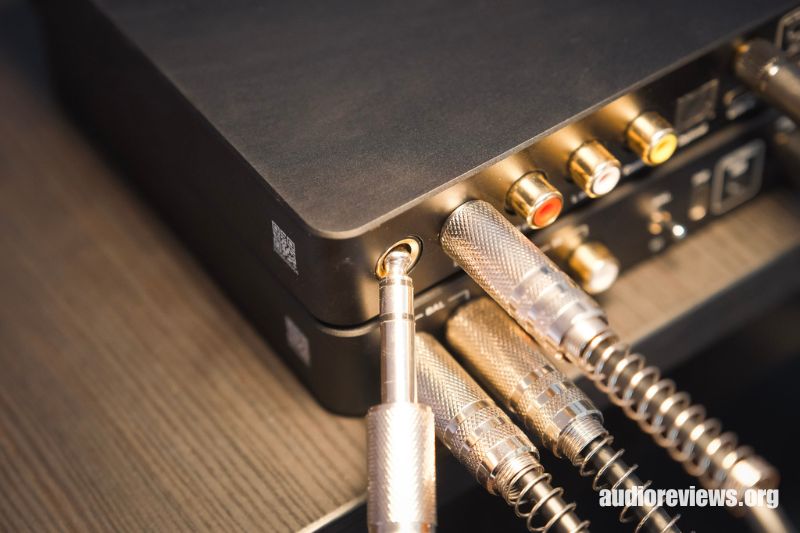
This is my first Topping DAC and upon pressing “play” I instinctively braced for a cold and analytical sound. Turns out my biases were unfounded. While there’s no doubt that the D50 III is technically capable, the overall tonality is very neutral and at times veers into warm territory by a hair. Maybe there is something to that new IV stage Topping claims they’re using here. Compared to other ES9039Q2M-based DACs I’ve heard, the is less of that trademark ESS vividness here.
Trying the D50 III with higher-end amps showed that the technical performance of the device is commendable and surpassing it would require going up to the 4-figure price bracket. Its peers can however display a more “tuned” house sound if that’s one’s preference. I imagine the D50III will easily find its way into many home systems because its DSP can counteract some room acoustics and the Bluetooth remote means you can keep it out of sight. It is of course up to question how long is the battery life of it versus a similar IR remote which doesn’t need to be constantly connected.
Select comparisons
Ifi Zen DAC 3
Priced at identical 229$ as the Topping D50 III, the Zen DAC 3 also can be powered from a USB port. It uses an unnamed DAC from Burr-Brown (now owned by Texas Instruments) and even offers both SE and BAL headphone outputs making it into a one-stop shop for desktop audio. The Zen DAC 3 also uses a rather exotic solution to output BAL line audio – a 4.4mm TRRRS jack on its back plate.
As with most other Ifi Audio products, the Zen DAC 3 has an unmistakable house sound. Some will like it more than the neutral presentation of the Topping D50 III, others might not. The Zen DAC 3 can also be bought as a ready-to-listen solution with its built-in headphone outputs with future upgrades like amps and linear PSUs in mind. The lack of DSP capability and a remote can be a dealbreaker for some.
SMSL D6S
Currently, at 199$ the SMSL D6S is a bit less costly than the D50 III and uses only one ES9039Q2M chip. On the other hand, it uses AC power so you’re not at the mercy of those often dirty USB power lines. The balanced outputs are also XLR so it’s easier to source cables. The form factor is very similar for both units with SMSL D6S offering a more legible display.
Sound-wise both DACs are extremely similar. The D6S has none of the D50 III warmth and renders the sound in a more ESS-like hi-fi fashion. Sonic preference for either unit will be very downstream equipment (and listener) dependent. The D6S has no built-in PEQ, if that’s important in your case.
Pairing notes
I found the Topping D50 III to work very well with just about everything I threw at it. If you like your amp and headphones as they are, the D50III won’t change that. If not, consider looking up measurement data and crafting a corrective EQ profile, the handy DSP function can transform most systems.
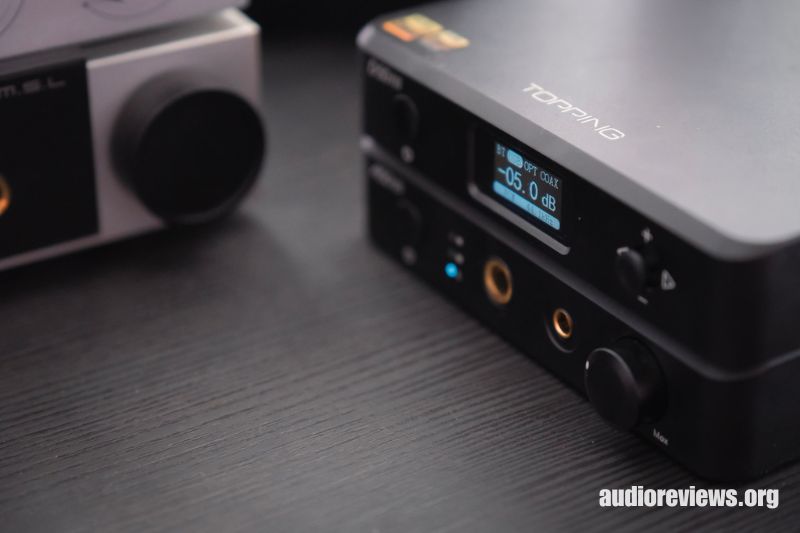
Concluding Remarks
There’s very little for me to criticize here, the Topping D50 III does what it says and then some. Its main claim to fame is the 10 band PEQ which is a first for Topping. With headphone and speaker EQ’ing becoming more popular, the D50 III allows the user to set and forget it. It’s also no slouch at sonic fundamentals like timbre, detail, and imaging but at the price point, it’s far from alone in that regard.
My verdict – 4/5
Disclaimer
Thanks to Shenzhen Audio for supplying the review unit. As always, they had no say in the review process and didn’t see the review before posting.



